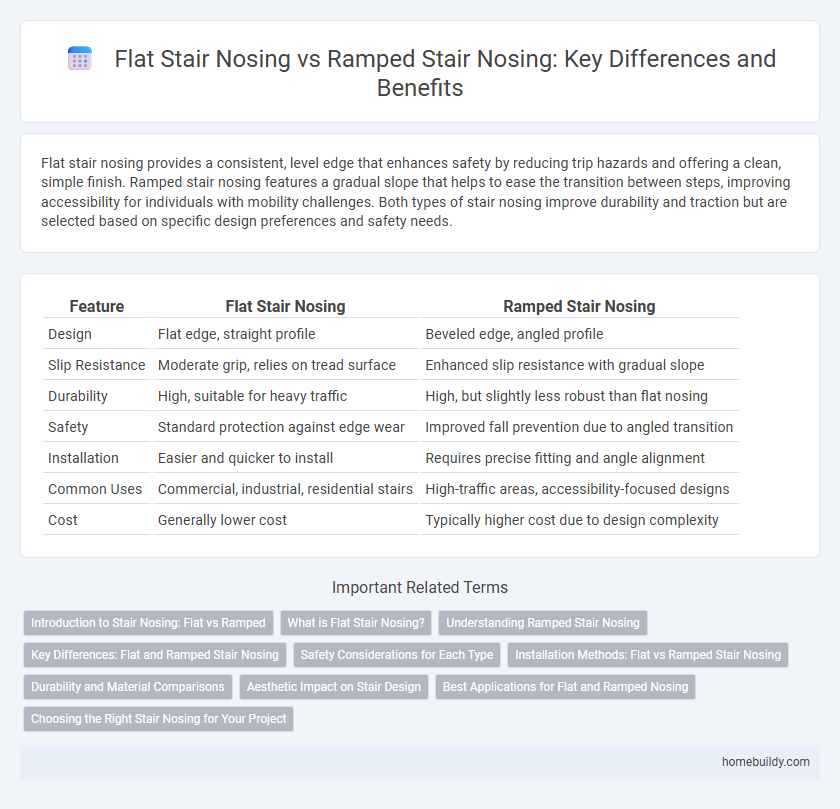Flat stair nosing provides a consistent, level edge that enhances safety by reducing trip hazards and offering a clean, simple finish. Ramped stair nosing features a gradual slope that helps to ease the transition between steps, improving accessibility for individuals with mobility challenges. Both types of stair nosing improve durability and traction but are selected based on specific design preferences and safety needs.
Table of Comparison
| Feature | Flat Stair Nosing | Ramped Stair Nosing |
|---|---|---|
| Design | Flat edge, straight profile | Beveled edge, angled profile |
| Slip Resistance | Moderate grip, relies on tread surface | Enhanced slip resistance with gradual slope |
| Durability | High, suitable for heavy traffic | High, but slightly less robust than flat nosing |
| Safety | Standard protection against edge wear | Improved fall prevention due to angled transition |
| Installation | Easier and quicker to install | Requires precise fitting and angle alignment |
| Common Uses | Commercial, industrial, residential stairs | High-traffic areas, accessibility-focused designs |
| Cost | Generally lower cost | Typically higher cost due to design complexity |
Introduction to Stair Nosing: Flat vs Ramped
Flat stair nosing offers a uniform, level edge that enhances safety by providing consistent traction and minimizing tripping hazards, ideal for areas requiring straightforward installation. Ramped stair nosing features a gradual slope that eases the transition between steps, improving accessibility and comfort, particularly in high-traffic or commercial settings. Both types contribute to staircase durability and compliance with building codes, but selection depends on specific use cases and aesthetic preferences.
What is Flat Stair Nosing?
Flat stair nosing is a horizontal edge trim installed on the front edge of stair treads to provide a smooth, level surface enhancing safety and durability. It offers a flush finish that minimizes tripping hazards, ideal for low-profile stair designs in residential or commercial buildings. Made from materials like aluminum, rubber, or vinyl, flat stair nosing improves stair tread protection while maintaining a sleek aesthetic.
Understanding Ramped Stair Nosing
Ramped stair nosing features a gradual slope designed to provide a smoother transition between steps, enhancing safety by reducing trip hazards and improving wheelchair accessibility. Unlike flat stair nosing, which has a uniform thickness, ramped nosing eases the edge profile, making it ideal for high-traffic or commercial environments where ADA compliance is required. Its ergonomic design also helps prevent wear on stair edges, extending the longevity of the staircase.
Key Differences: Flat and Ramped Stair Nosing
Flat stair nosing provides a level, horizontal edge that enhances safety by offering a consistent surface for foot placement, ideal for areas requiring uniform step edges. Ramped stair nosing features a gradual incline designed to ease transition between stair and floor, improving wheelchair accessibility and reducing tripping hazards on entryways. Material composition often varies, with flat nosings favoring durable, slip-resistant options and ramped nosings incorporating smoother finishes to accommodate wheeled traffic.
Safety Considerations for Each Type
Flat stair nosing provides a uniform surface that reduces tripping hazards by creating a consistent step edge, ideal for environments requiring enhanced slip resistance and clear visual demarcation. Ramped stair nosing offers a gradual transition between steps, minimizing the risk of sudden impact by easing the foot's movement, which is particularly beneficial in areas with heavy foot traffic or for individuals with mobility challenges. Safety considerations revolve around the choice of material and texture, where anti-slip coatings and contrasting colors enhance visibility and traction for both flat and ramped designs.
Installation Methods: Flat vs Ramped Stair Nosing
Flat stair nosing installation involves securing a uniform, level strip directly to the stair edge, typically using screws or adhesive, offering straightforward alignment and quick application. Ramped stair nosing requires precise angle adjustments to match the incline of the stair tread, often involving custom fitting and specialized fasteners to ensure a seamless transition and enhanced slip resistance. The choice between flat and ramped nosing impacts installation time, labor complexity, and overall safety compliance.
Durability and Material Comparisons
Flat stair nosing typically offers greater durability due to its uniform thickness, often crafted from robust materials like aluminum or PVC that resist wear and impact. Ramped stair nosing, while providing a smoother transition to prevent trips, usually employs softer materials such as rubber or softer metals, which may wear faster under heavy foot traffic. Selecting between flat and ramped nosing depends on balancing the need for long-lasting material performance with the desired level of slip resistance and comfort.
Aesthetic Impact on Stair Design
Flat stair nosing offers a sleek, unobtrusive look that seamlessly integrates with modern stair designs, emphasizing clean lines and minimalism. Ramped stair nosing introduces a subtle curvature that enhances the visual flow and softness of the staircase, often complementing traditional or transitional aesthetics. Choosing between flat and ramped stair nosing significantly influences the overall style, with flat nosing providing a contemporary edge and ramped nosing contributing to a more organic, inviting appearance.
Best Applications for Flat and Ramped Nosing
Flat stair nosing provides a stable, durable edge ideal for high-traffic commercial areas where slip resistance and straightforward installation are priorities. Ramped stair nosing is best suited for accessibility compliance in residential and public buildings, creating smooth transitions between stair treads and floors to accommodate wheelchairs and reduce trip hazards. Selecting flat nosing benefits industrial environments requiring heavy-duty protection, while ramped nosing excels in settings emphasizing safety and comfort for people with mobility challenges.
Choosing the Right Stair Nosing for Your Project
Flat stair nosing provides a clean, minimalistic edge ideal for indoor applications with low foot traffic, enhancing safety without altering stair height. Ramped stair nosing features a gradual slope that reduces trip hazards and supports ADA compliance, making it suitable for commercial spaces and high-traffic areas. Selecting the right stair nosing depends on factors like foot traffic intensity, location, and safety regulations to ensure durability and user accessibility.
Flat stair nosing vs Ramped stair nosing Infographic

 homebuildy.com
homebuildy.com